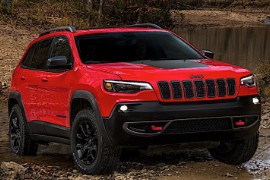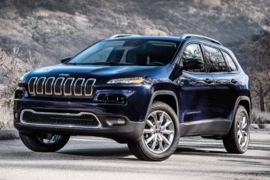JEEP Cherokee Models/Series Timeline, Specifications & Photos
First production year: 2013
Engines: Gasoline, Diesel
Body style: SUV (Sports Utility Vehicle)
Jeep introduced a heavily revised version of the Cherokee KL at the North American International Auto Show for the 2019 model year at the beginning of 2018.
Ever since 1974, Jeep has delighted its customers with the Cherokee. While the first generation relied on a body-on-frame solution, the second generation, introduced in 1984, came with the brilliant solution of welding the frame to the bodywork. That was the famous XJ, which became the first true compact crossover on the market. It was followed by two other generations named Liberty because Chrysler was reluctant to call it Cherokee. Then, in 2013, it dusted off the nameplate and placed it on a new generation, which was received with mixed feelings by the brand’s fans. While some features of that model were appreciated, others were not. The 2019 model year came to fix them. It was the kind of a facelift that could have passed as an entirely new generation. But FCA, the alliance’s name in 2018, was honest. The SUV was built on top of the same platform, and despite all the improvements, it was not a new vehicle.
At the front, the front fascia was entirely new. It featured new headlights resembling eagles’ eyes and integrated LED daytime running lights. Between them, the traditional seven-slat grille of the Jeep was adorned with chromed elements. At the same time, the lower bumper featured an additional air intake flanked by the available fog lamps. For the upper grades, such as the Trailhawk, the automaker installed a black lower bumper area adorned by red tow hooks.
From its profile, there were significant differences between the grades. Vehicles fitted with front-wheel drive systems sat lower to the ground than the Trailhawk version. Still, the trapezoidal-shaped wheel arches were adorned with black trims continued by same-color side sills. The body-colored door mirrors and handles gave the vehicle an upscale look. Behind, the automaker also made a clear distinction between the Trailhawk and the lower grade version of it by installing a black lower bumper with a red tow hook, while the others had body-colored ones.
Inside, the changes were massive. The automaker dramatically improved the cabin, adding soft-touch materials on the dashboard and other contact surfaces. In addition, the armrest between the front passengers featured a two-tier storage area. On the center console, in front of the gear selector, Jeep placed a USB charging port and even a tray to store the mobile phone while it was charged. Fronting the driver was the same-looking instrument cluster as before, with two large dials for the speedometer and tachometer that flanked a thin TFT display for the car’s onboard computer. A nice detail was about the adaptive cruise control system, which, when approaching the vehicle in front, displayed an old 1941 Willy’s Jeep. The automaker also upgraded the infotainment system, which featured Android Auto and Apple Carplay.
Under the hood, the 2019 Cherokee was available with three gasoline engines paired with a nine-speed automatic transmission. The base model came with a 2.4-liter inline-four, followed by a 2.0-liter turbocharged four-pot, and finally a 3.2-liter V6 featuring variable valve timing technology. For selected markets, Jeep also offered the Cherokee with a 2.2-liter turbodiesel provided by Fiat.
Jeep introduced the fifth generation of the Cherokee at the 2013 New York Auto Show as the 2014 model year, with sales starting in the fall of same year, and it was a radical change for this nameplate.
After two generations of the Liberty (the KJ and the KK), Jeep brought back the Cherokee nameplate for the KL generation. Unlike those, the new model came with a completely new design approach. It was also a turning point for the interior features, which were richer than before. It looked like Chrysler tried to move the Jeep brand into the premium segment, or at least to make it family-friendly. The American automaker and Fiat co-developed a new platform for the crossover and shared it with the Chrysler 200, which was a sedan. Despite criticisms from hard-core fans, the Cherokee finally exceeded the 200,000 sales mark in the U.S. alone in its first production year. In addition, since the car was available worldwide, it reached the 355,000 units milestone in 2016.
At the front, besides the seven-slat grille, the 2013 Jeep Cherokee KL had no visual connection with any of its predecessors. It featured a pair of eyebrow-like daytime running lights positioned above the bumper. Below, inside the rectangular scoops, were the headlights. At the same time, on the lower side of the bumper, flanking a secondary air intake, the automaker placed the round fog lamps. The unusual design was emphasized by the hood, which sported a power bulge in the middle.
The 2014 Jeep Cherokee left behind the flat panels and the rugged appearance, even though it could still tackle some difficult off-road trials. To emphasize the SUV's origins, the automaker kept the design idea of trapezoidal wheel arches and adorned them with narrow black plastic moldings with matching-color side sills. Depending on the grade, the car could also boast a set of metallic skid plates, which make it look more appropriate to the brand's origins. At the back, instead of the vertically corner-mounted taillights, Jeep preferred a set of horizontally LED ones, which stretched from the quarter panels onto the tailgate.
Customers found a comfort-oriented cabin that resembled an elegant hatchback. Right off the bat, Jeep offered the 2014 Cherokee in four grades: Sport, Latitude, Trailhawk, and Limited. Later, three others joined the list: Altitude Edition, Overland, and X. Fronting the driver was an instrument cluster that housed the speedometer and the rev counter, flanking a color TFT display that showed additional data from the car's onboard computer. At the same time, integrated into the upper side of the center stack, the automaker introduced an 8.4" touchscreen for the infotainment system that featured navigation and had onboard storage for media. The cabin was upholstered with fabric for the lower grades, while the upper ones featured a leather-wrapped interior. Up front, the 2014 Cherokee featured two bucket seats, while in the back, there was a split-folding (60/40) bench seat for three adults.
Under the hood, the automaker installed a choice of gasoline engines for the North American market, while in other countries, the Cherokee was fitted with turbodiesel engines as well. Power went to the front or in all corners, and not all versions were available with a low-range transfer box. Depending on the grade and options, a disconnectable rear axle transmission was available, which reduced fuel consumption.

